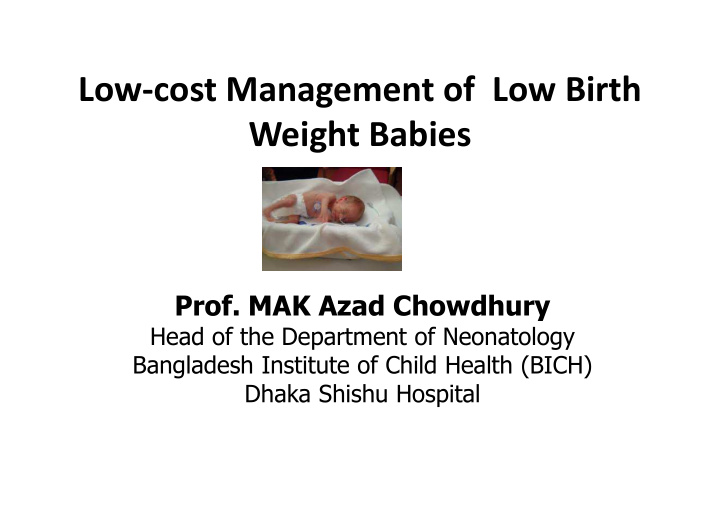



Low-cost Management of Low Birth Weight Babies Prof. MAK Azad Chowdhury Head of the Department of Neonatology Bangladesh Institute of Child Health (BICH) Dhaka Shishu Hospital
Objective of the presentation • To emphasize that management of the LBW babies does not cost much and high-tech facility is not required in most of the cases. of the cases. • They can very well be managed at the district and sub-district hospitals and undue referrals and sufferings beavoided.
Premature babies can be saved before intensive care is available... Public health approaches Improved individual neonatal care eg feeding, warmth, hygiene, antibiotics, resuscitation Neonatal intensive care introduction and scale up: Over 60% reduction can be achieved before neonatal intensive care Over 60% reduction can be achieved before neonatal intensive care and history shows the impact would be huge and history shows the impact would be huge Data sources for UK and US historical data: (CDC, 2012, Office for National Statistics, 2012, NIH, 1985, Smith et al., 1983, Data sources for UK and US historical data: (CDC, 2012, Office for National Statistics, 2012, NIH, 1985, Smith et al., 1983, Jam Jamison et al., 2006, ison et al., 2006, Lissauer Lissauer and and Fanaroff Fanaroff, 2006, Baker, 2000, Philip, 2005, , 2006, Baker, 2000, Philip, 2005, Wegman Wegman, 2001). With thanks to Boston Consulting Group , 2001). With thanks to Boston Consulting Group
METHODS As an example we present management of LBW babies in Dhaka Shishu Hospital in recent years in the special care baby unit. Dhaka Shishu (Children) Hospital (650 Beds) provides Dhaka Shishu (Children) Hospital (650 Beds) provides primary, secondary as well as tertiary care services to primary, secondary as well as tertiary care services to sick children. There is 1 NICU and 1 Paediatric ICU where some critically ill babies are taken care of, most of the low birth weight babies are managed in the baby cots and in the words without any high-tech device.
Low Birth Weight Babies LBW 35% 65% 65% 354/995
Categories of LBW Babies 194 200 (55%) 93 180 160 (26%) 140 39 120 100 80 28 (8%) 28 (8%) (11%) (11%) 80 60 40 20 0
Co-morbid conditions with LBW 42% 45 40 35 30 25 20 15 12% 12% 12% 12% 8% 10% 8% 10% 15 6% 5% 10 2% 2% 1% 5 0
Cleanliness and Hygiene
Cleanliness and Hygiene
Keeping warm Keeping warm Wrapping the baby covering head
Keeping warm Keeping warm
Incubator care
Breast feeding of premature/LBW infant Breast feeding of premature/LBW infant 1300gm Baby 1300gm Baby
1150gm Baby
Gavage Gavage Feeding Feeding
Fluid Management IV Fluid Aliquot 6/8 hourly Aliquot 6/8 hourly
Antibiotics • First line-Ampicillin +Gentamicin • Second line-Ceftazidine + Amikacin • Third line-Meropenum+Nitilmicin • Third line-Meropenum+Nitilmicin
Incubator Care 250 200 150 150 100 45% 100% 5% 50 0 <1000 gm 1000-1300 gm >1300 gm
Outcome of <1300 gm Babies 60 50 40 31% 30 33% 33% 20 20 10 0 Incubator Care No Incubator Care
Phototherap y
PDA Closure • Fluid restriction • Diuretics • Drugs- (if platelet count is not very low) • Drugs- (if platelet count is not very low) - Ibuprofen-10mg/kg/dose-1 st day, 5mg / Kg/day daily- another 2 days - Paracetamol-15mg/kg/dose QDS daily-3 days
KMC in Dhaka Shishu Hospital • Since July, 2013, 596 received KMC care in our unit • Successfully discharged 554 cases and are being followed up. being followed up. • Twenty five cases died, 17 cases DORB(7.1%).
Neonatal age Six months age
KMC (For twin)
Weight gain & Hospital stay Variable Case (n=60) Control (n=40) p-value Mean Hospital stay Mean Hospital stay 15.61±10.56 15.61±10.56 18.15±4.5 18.15±4.5 0.1545 0.1545 (days: mean±SD) Weight gain (gm: 299.41±219.27 126.00±347.74 0.0029 mean±SD)
Other effects • Effective thermal control • Reduced apnea • Reduced apnea • Reduced infection
Overall Mortality of LBW 16% 84% 84% Died
Mortality of KMC Babies 7.1% Survived Survived Died 92.9%
ROP Screening <34 Weeks/ 1800gm >3 Weeks Post Natal age
ROP Screening 173 cases screened from Nov 2014 to Sept 2015 ROP Present 47 (27%) Laser Therapy Laser Therapy 22 (13%) 22 (13%)
Identified Risk Factors for ROP Risk Factors Number (%) Blood transfusion 11(7% ) Oxygen Therapy 35(20% ) Septicemia 21(12% ) RDS 13(8%)
CPAP
Conclusion Replicating this model throughout the country along with appropriate supply of antibiotics and orientation of the paediatricians will contribute of the paediatricians will contribute significantly to reduction of the high neonatal deaths in Bangladesh.
Thank You very much
Recommend
More recommend